How Many Lexus Lfa Were Made
Skip to ContentSkip to Footer
Lexus LFA: history, review and specs of an icon
The Lexus LFA's long-winded gestation may have put a dampener on our initial enthusiasm, but the LFA really is something special
There is a small but illustrious group of supercars that all share one very telling attribute. The Lexus LFA, Bugatti Veyron, and even the original Ford GT40 are part of this club, but it's not an engine type or design language. It's a philosophy.
If you haven't guessed by now, all of these cars were personal pet projects, funded by multinational car manufacturers to fulfil the requirements of their respective and exacting CEOs. Whether it was built to settle a vendetta like the Ford, or an exercise in technical superiority like the Bugatti, the personal project car rarely if ever makes financial sense for manufacturers, but usually creates some pretty special cars in the process.
> Lexus LC 500 Coupe review – Lexus's buji coupe a brilliant alternative GT
The LFA was the vision of Toyota CEO Akio Toyoda. After years of underwhelming product, a world-beating supercar was on the agenda, although the car Toyota ended up with was likely vastly different to the car Mr Toyoda initially imagined.
Designed to reflect Toyota's fruitless Formula One campaign, by the time the V10-powered supercar finally reached the road it was considered overpriced, underpowered and saddled with a problematic gearbox. But the reality is that away from contemporary rivals, the LFA has more than proved its worthiness.
History
The LFA name first appeared in 2005, with Lexus revealing the first LF-A concept car at the Tokyo motor show, but development of a Toyota/Lexus supercar began some five years before, with the project actually kicking off in early 2000. After five years of development, the initial LF-A concept was aesthetically close to the eventual production car, sharing the same surfacing quality and overall silhouette. But the concept was built on an aluminium chassis and as development continued, so the car's estimated kerb weight began to become a liability.
To negate the weight gain, the already five-year initial development period was pushed further, when Toyota decided to instead construct the car entirely from carbonfibre. To coincide with the change of building method, Lexus launched another concept in 2007, again called LF-A, but this time with more dramatic styling and now publicly confirming a future production version.
The road car was finally revealed at the 2009 Tokyo motor show, along with a £340,000 price tag and confirmation that only 500 units would be built. Thanks to its long-winded development and expensive carbonfibre construction, the LFA road car (now without the hyphen) was still a loss maker for Toyota despite its huge price tag.
The LFA was not universally praised on its release either, with many writing it off as an expensive irrelevance thanks to its relative performance disadvantage compared to cheaper mass production rivals. As time has gone on though, its flaws are much easier to overlook and the LFA's incredible engine and stunning build quality have risen above the usual critique that is justifiably levelled at cars when they are brand new.
Lexus also brought out a more track focused Nurburgring package later in the LFA's lifecycle, featuring a more aggressive front splitter, fixed rear wing and new, lighter wheels. Together with retuned suspension and an 11bhp power boost, the package cost an extra £63,600 over the top of the standard car bringing the total cost to over £400k.
> Click here for our drive of the LC 500 coupe
Engine and Transmission
If there is one component that defined the LFA, it's the naturally aspirated 4.8-litre V10 engine. It's not the most powerful unit, in fact the V10 in a Porsche Carrera GT that preceded it by 6 years produced more horsepower. But, if judgement was to be made on how a car produced its power, the LFA is a complete masterclass of internal combustion.
The V10 itself, named 1LR-GUE by Toyota, was co-developed with Yamaha and is completely bespoke. Built from an aluminium, magnesium and titanium alloy, Toyota boasted that the 4805cc V10 was smaller than a traditional V8 and the same weight as a V6. The 'GUE' was built to an incredibly high tolerance, featuring electronic individual throttle body control, a dry-sump lubrication system and lightweight forged internals to reduce internal inertia as much as possible.
Peak power was rated at 552bhp at a head spinning 8700rpm, while peak torque was 354ft lb at 6800rpm. The engine's true capability was not just about on paper performance though, as the unit itself was often likened to a musical instrument in the way it responded – perhaps no coincidence given Yamaha's involvement. It was so intricately engineered that it was able to rev between idle and its 9500rpm redline so quickly a traditional tachometer needle was not able to keep up.
To achieve a near perfect weight distribution, the LFA used a transaxle layout, with its gearbox mounted at the rear and connected to the engine via a rigid torque tube. Curiously, Lexus also placed the exhaust system in the same transmission tunnel to bring the driver and passenger further inboard. This was done for the benefit of the LFA's centre of gravity and mass, putting as much weight as possible closer to the centre-line of the car.
The LFA's powertrain weakness lay in its single-clutch semi automatic gearbox. Unable to match the response or driveability of gearboxes in cheaper rivals, the main issue was that by the time the LFA reached the showroom floor Ferrari was already integrating vastly superior dual-clutch gearboxes into its line up – as were Audi and Mercedes-Benz.
> Click here for our review of the Ferrari 599 GTO
Suspension, steering and brakes
The opportunity for Toyota to create a bespoke chassis for the LFA meant there was very little mechanical compromise to be deal with. As a result, Lexus decided there was no need for adaptive dampers, instead utilising coil-over dampers attached to front double wishbone suspension and a multilink rear axle. The brakes are relatively standard six-piston Brembo monoblock calipers up-front and four-piston on the rear, gripping carbon ceramic discs, but the setup had incredible stopping power.
Interior
The LFA may have been a little pricey at launch, but it's likely that people with the means to buy one wouldn't have been bothered by it. Lexus has rarely let down customers with its interiors, but a car like the LFA really needed to shine to justify the enormous price tag in the showroom. And, just like the exquisite engine, the result was a cleverly designed and beautifully executed space that made you feel like you were driving something really special.
Aesthetically unlike any other Lexus cabin, the LFA artfully integrated the infotainment and HVAC controls into a striking sweeping centre console, while the infotainment screen was smartly hidden away. The LFA was also the first Lexus to get digital dials, combined with a metallic bezel that changed the display depending on the driver mode. As mentioned earlier, the LFA required a digital rev counter as a traditional needle would have been unable to keep up with the rate of which the engine revved.
The materials used were just as indulgent and specialised as those used elsewhere in the LFA too. Milled aluminium and magnesium were used for the switchgear and indicator stalks, polished carbonfibre for the steering wheel, and waxy soft leather for the sculptural seats and dash-top. It was expertly put together in a way that was unheard of for a car in limited production and helped elevate the LFA to a point beyond rivals like the Ferrari 599 GTO.
Rivals
At £340,000 it's likely that potential customers could buy the LFA in addition its rivals if they wanted to, rather than having to make a choice between one car and another, but working in a matter of context the LFA's price doesn't sound as ridiculous as it once might have.
The LFA's closest rival in terms of price, capability and exclusivity was the Ferrari 599 GTO. Limited to 599 units, the GTO was priced at £305,000, offered more performance from its equally musical V12 engine, but was definitely more of a hardcore, stripped-out racer than the comparatively sumptuous LFA.
Lamborghini's Aventador arrived around a year later, offering even more power from its 6.5-litre V12 and was also around £100k cheaper, but due to its series production status lacks the rarity factor of the other two cars.
The fact is though, that the LFA has not lost any of its value in today's market, and ignoring the 599 GTO's insatiable rise in prices like all limited edition Ferraris, has proven a fairly safe investment in the years since its launch, mean it's ranked among some of the more valuable Japanese cars of any type.
Specifications
| Engine | V10, 4805cc |
| Max power | 552bhp @ 8700rpm |
| Max torque | 354lb ft @ 6800rpm |
| Transmission | Six-speed semi-automatic, rear-wheel drive |
| Tyres | 265/35 R20 Y front, 305/30 R20 Y rear |
| Weight (kerb) | 1614kg |
| Power/weight | 342bhp/ton |
| 0-62mph | 3.7sec (claimed) |
| Top speed | 203mph (claimed) |
| Price | £340,000 (2010) |
What we said
Lexus LFA, This is evo ( evo 200, October 2014)
'There's so much to the LFA that's exceptional, yet still its banshee V10 engine is the thing that makes the most immediate and lasting impression. The throttle response is totally insane, to the point where even the Carrera GT's motor feels a little tardy by comparison. It also sounds as good inside the car as it does outside - something the Porsche fails to do… the only real flaw, beyond the shallow and predictable accusation of the Lexus badge not carrying sufficient kudos, is the single-clutch paddleshift gearbox.
'What I do know is the LFA steers with greater precision and a sweeter rate of response than the Porsche, smothers bumps and rides poor surfaces with more control and tracks truer and with less distraction from cambers and surface changes. In short it's every bit as involving, but more exploitable. What I find most extraordinary is that while it has the CGT's intensity and excitement when fully lit, it's much the nicer car to be in when you're simply making progress or covering miles.'
We also attended the European launch of the Lexus LFA back in 2009 - keep reading on the next page for our full review by John Simister
What to pay
The LFA's £350k price tag looked steep when new (and doesn't seem inexpensive today), but in the intervening years a gradual appreciation for its engineering, its rarity and its unique abilities have led to it attaining much higher figures down the line.
At the time of writing there is an example for sale in the United States at around £375,000, which is no great increase over new (in fact it's cheaper than new, relative to inflation), but cars in the United Arab Emirates, the UK and Japan are listed at around £500,000, and another in the UK for over £530,000.
In March 2019, an orange Nurburgring package car crossed the block with RM Sotheby's at $918,500 in Scottsdale, Arizona - around £684,000. While recent events have led to uncertainty even at this level in the market, likely softening prices, it still looks like you'll realistically need around half a million to get into an LFA right now...
Continue Reading
More on LFA
Lexus LFA art car revealed, debuts at 24 Hours of Spa

Lexus LFA coupe
Lexus LFA art car revealed, debuts at 24 Hours of Spa
Portuguese artist paints sharp supercar with not-so-sharp graphics
25 Jul 2018
Lexus RC-F: show video
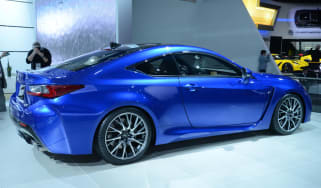
Lexus LFA coupe
Lexus RC-F: show video
Lexus has revealed its new BMW M4-rivalling RC-F concept, at the Detroit motor show. Video, specs, details and prices here
16 Jan 2014
Lexus LFA
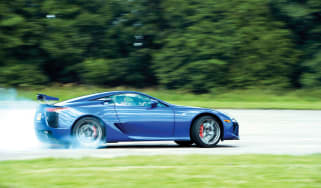
Lexus LFA coupe
Lexus LFA
The Japanese luxury car maker hit the bullseye with its very first supercar
3 Sep 2013
Lexus LFA tribute video
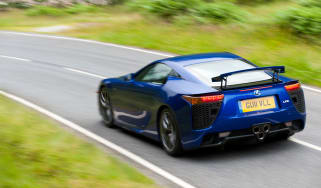
Lexus LFA coupe
Lexus LFA tribute video
As Lexus LFA production ends, its creator pays tribute to the screaming V10 supercar
3 Jun 2013
Lexus LFA production ends

Lexus LFA coupe
Lexus LFA production ends
After a production run of 500, the final V10 Lexus LFA supercar has rolled off the production line in Japan
20 Dec 2012
Video: Alex Wurz drives the LFA

Lexus LFA coupe
Video: Alex Wurz drives the LFA
Former F1 driver and Le Mans star Alex Wurz tests the Lexus LFA at the Estoril circuit in Portugal
24 Feb 2012
Lexus LF-LC revealed
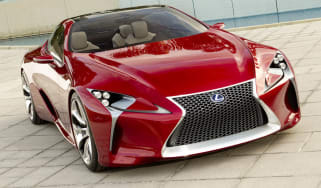
Lexus LFA coupe
Lexus LF-LC revealed
Official pictures of the new Lexus LF-LC coupe concept revealed ahead of its Detroit show debut
4 Jan 2012
Lexus LFA Nurburgring
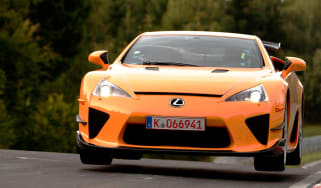
Lexus LFA coupe
Lexus LFA Nurburgring
Chris Harris presents a video review of the Lexus LFA Nurburgring Edition at - where else - the Nurburgring
11 Oct 2011
LFA laps 'Ring in 7:14
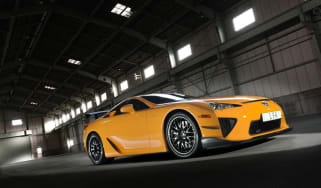
Lexus LFA coupe
LFA laps 'Ring in 7:14
The Nurburgring edition LFA has set a blistering unofficial lap time around the Nordschleife. Details and image gallery.
5 Sep 2011
Lexus LFA vs IS-F video

Lexus LFA coupe
Lexus LFA vs IS-F video
New Lexus LFA V10 supercar displays power on track run with IS-F V8 sports saloon sibling
23 May 2011
Lexus LFA Nurburgring
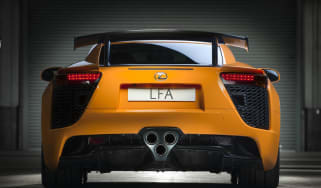
Lexus LFA coupe
Lexus LFA Nurburgring
Lexus will take the LFA Nurburgring Package to the 2011 Geneva motor show. Big picture gallery here
24 Feb 2011
LFA gets 'Ring pack
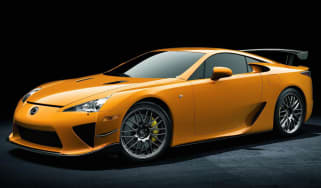
Lexus LFA coupe
LFA gets 'Ring pack
Lexus adds a 'Ring handling pack to the LFA. When's the lap time going to be announced?
29 Mar 2010
Skip to HeaderSkip to Content
Source: https://www.evo.co.uk/lexus/lfa#:~:text=The%20road%20car%20was%20finally,500%20units%20would%20be%20built.

0 Komentar